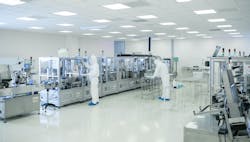Engineering Angles: Material handling matters
When it comes to designing a pharma facility, a complete understanding of the processes, equipment and space required to manufacture products is critical.
At the start of any new production line project, you’ll need to know what steps are involved in the product’s manufacture. For an oral solid dose manufacturer, commonly the focus of attention is on the processing stages of granulation, compression, coating and packing. But careful consideration must also be given to the ways in which powders, granules, tablets and capsules are handled and moved from each stage of the production process. Often overlooked, or not considered early enough in the facility design process, are the questions: “How are the materials moved from one process step to another?” “What is the best way to do this?”
Without fully considering these fundamental questions when designing a facility, the manufacturer not only risks compromising the productivity of a given product line, but also limiting future potential for expanding capability and capacity.
While the actual processes involved in OSD product manufacture are of course crucial, the materials handling methods required to move between these processes are often overlooked during the design phase, and these can introduce time, energy and profit-sapping inefficiencies.
Of course, there is not a “one size fits all” solution to materials handling. Not only do different product lines with different ingredients and formulations have different materials handling requirements, factors such as building space constraints, containment requirements, material characteristics, regulations and budget must also be considered to arrive at the optimum facility design.
A compression phase example
Ignoring the materials handling element of the project can have a detrimental effect on the production efficiency and capability in the longer term.
Take, for example, the compression stage: The space needed to operate within is considered and designed accordingly, and thought must be given as to how the powder or granular ingredients will be delivered to the inlet of the machine, and how the compressed tablets will be collected. The ways in which input and output materials are handled and moved can affect the optimal production set-up more than the compression process itself.
If you plan to tip material into the tablet press by hand, or use a vacuum system then a single floor facility with a low ceiling height would suffice.
However, if drums or intermediate bulk containers (IBCs) are to be used to feed materials in to the tablet press, a taller room height would be needed to accommodate a gravity feed system. At this point, it is worth considering using a dedicated materials handling floor above the compression room, creating a two-floor facility, or using a mezzanine level.
This example considers only one stage of the process, and for only one type of product, yet there are many more decisions that are taken concerning materials handling further down the line.
Consideration also needs to be taken on how pressed tablets will move to the coating machine or to the bottling area. Should the tablet press outlet be coupled directly to the next stage of the pipeline, or are tubs, boxes or drums more efficient in moving tablets from one area to another?
Achieving optimal materials handling efficiency should be a key driver in facility design. Whether starting from scratch, or adapting an existing building, getting it right from the outset and creating the “leanest” environment possible will undoubtedly pay dividends.
